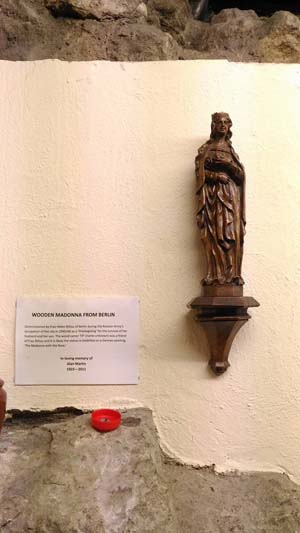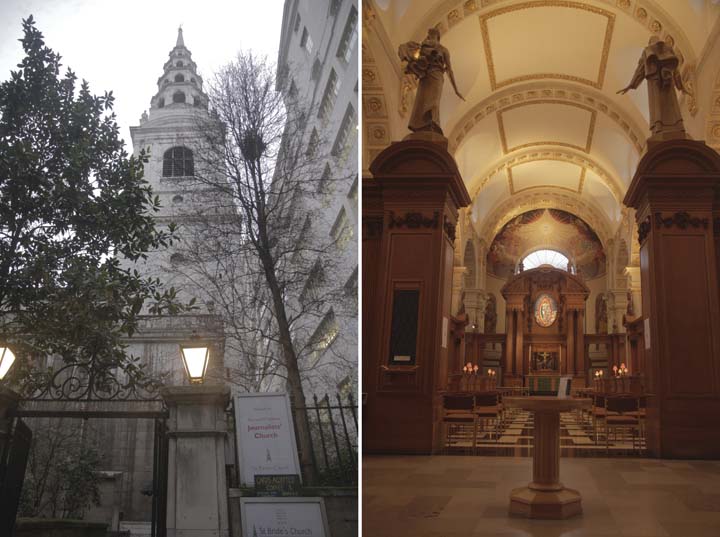By C. Mendez Legaspi / Photos by Jowee Winstanley-Morel
LONDON, England—During the “Space for Silence” hour, between 5 and 6 p.m., only the flicker of candles illuminate the interior of Saint Bride’s Church tucked in a corner off Fleet Street.

The atmosphere hearkens one back to the Middle Ages, when such lighting was then the mode. Quite fitting for this church, which became the “Cathedral of Fleet Street” after Wynkyn de Worde established a printing press with movable type in the church premises in 1501.
The location for de Worde’s business, between London and Westminster, was strategic because the clergy were the most literate social class at the time, and were, thus, the target market.
Soon after, Fleet Street eventually attracted poets and playwrights, and became a haven for print journalists.
In 1702 the Daily Courant, London’s first daily newspaper, began publishing. It was followed by the Morning Chronicle. By the 1880s the “penny press” (newspapers selling at 1 penny) became popular.
By the 20th century the national media (including the Daily Express and the Daily Telegraph) called Fleet Street its traditional address. But, in 1986, Rupert Murdoch’s News International (which publishes The Times and The Sun), claimed that it was impossible to be profitable at Fleet Street anymore, and moved his offices to Wapping East London.
Though other publications also moved away, Fleet Street today is still associated with the printing and publishing sector, and Saint Bride’s remains the spiritual home for journalists.

Ancient Church
Saint Bride’s is said to be named after Saint Brigid of Kildare, or Brigid of Ireland (c. 451-525), one of Ireland’s patron saints. But the church site, as some reports claimed, was used by the Romans as a temple some six centuries earlier.
The church was one of the structures destroyed by the Great Fire of London in 1666. It was rebuilt by the great English architect Sir Christopher Wren, who also built Saint Paul’s Cathedral, his masterpiece which is a few steps away from Saint Bride’s.
In 1940 the church was again demolished by German bombs in World War II. Before rebuilding was completed, the medieval archaeologist Professor W. F. Grimes made astonishing discoveries amid the rubble: the foundations of all six previous churches on the site, including the remains of temple mosaic pavements dating back to Roman times.
Another surprise was the excavation of 7,000 skeletons interred at the crypt of victims of the Great Plague of 1665 and the cholera epidemic of 1854. Some tombstones can be viewed at the crypt museum below the church.
There is also a chapel underground that serves as a memorial to the Harmsworth family (the mass-circulation newspaper proprietors like the Daily Mirror) and the staff of Associated Newspapers (Daily Mail, MailOnline, Mail on Sunday, Metro) who were killed in the line of duty covering the two world wars.

Romantic connection
Spared from devastation from the German onslaught, fortunately, was the distinctive multi-tiered tower that architect Wren added to Saint Bride’s in 1703.
Legend has it that a baker named William Rich wanted to make a special cake for his wedding to a master baker’s daughter.
He got inspired by the steeple of Saint Bride’s, the venue for their wedding. So he created a cake in tiers, with each tier smaller than the previous one. Thus, giving birth to the traditional design of the wedding cake we are familiar with to this day.
Journalists’ altar
The English Baroque church is a Grade I-listed building, which means it is deemed by the Historic Buildings and Monuments Commission for England to be of “exceptional interest.”
Knowing this and its importance to my chosen profession, my filmmaker/host/friend and I entered the church with bated breath. Wrapped in darkness, the mood is so solemn and the silence so comforting after our frantic rush from the Buckingham Palace.
There are candles at the main altar. A few churchgoers, seeking sanctuary from their toxic workplace outside, sit in complete reverie at the pews.
But what draws the eye more are the candles on the north aisle, the Journalists’ Altar, where every day prayers are being said for media practitioners who put their lives at risk to spread the “truth at all costs.”
Pictures of the dearly departed, who worked for media entities, are displayed atop the altar. Some of them died naturally, while most perished in the line of fire.
Below the names and photographs is the biblical passage: “And the word was made flesh and dwelt among us.”
This altar was the site for all-night vigils for prayers for journalists John McCarthy (United Press International Television News), Terry Anderson (the Associated Press) and all the other hostages held by Islamic jihadists during the Lebanon Crisis from 1985-1991.
After their release, the altar “serves as a constant vigil for those across the globe who have put themselves in grave danger so that we can be informed of events and regimes that could otherwise go unscrutinised,” stated in Saint Bride’s literature.
A marker reads: “At this altar day by day, we pray for all those who face danger, persecution and death in bringing the truth in word and pictures to a trouble world.”
The literature continues: “Our ministry to journalists, and to those working in every area of the media industry, remains one of the most important and distinctive aspects of our life at Saint Bride’s. That ministry is never more apparent than at our annual Journalists’ Commemorative Service, which is attended by leading figures in the world of the press, television, radio and digital media.
“During the service we light candles for journalists, photographers, camera crew and support staff who have died or who have been killed on the frontline; we remember also those who are missing, imprisoned or held hostage; and we also hold in prayer those who are out in the field, covering stories at great personal risk to themselves.”
Looking at the pictures at the altar, I couldn’t help but wish that the 34 journalists killed in the 2009 Maguindanao Massacre are part of the memorial. The Committee to Protect Journalists (founding honorary chairman was Walter Cronkite, the Philippines’s Sheila Coronel of the Graduate School of Journalism, Columbia University is a board of director), has called it “the single deadliest event for journalists in history.”
Prayer for journalists
“Saint Bride’s, Fleet Street is a warm and welcoming Christian community, and one of the most famous and most fascinating historic churches in Central London,” Alison Joyce, rector of Saint Bride’s, said in a message. “A place of Christian worship for 1,500 years, we continue to proclaim the love of God here. Whether journalist, tourist, city resident or worker, you will always be made welcome.”
When press freedom is under attack, and fake news and disinformation prevalent in the Philippines at present, a visit to the Journalists’ Church takes on more meaning.
Saint Bride’s offers a prayer from Saint Francis de Sales, patron saint of writers and journalists:
“Almighty God, strengthen and direct, we pray, the will of all whose work it is to write what many read, and to speak where many listen. May we be bold to confront evil and injustice: understanding and compassionate of human weakness; rejecting alike the half-truth which deceives, and the slanted word which corrupts. May the power which is ours, for good or ill, always be used with honesty and courage, with respect and integrity, so that when all here has been written, said and done, we may, unashamed, meet Thee face to face. Amen.”
As with the rebuilding efforts after World War II, Saint Bride’s relies on the generosity of benefactors for its continued maintenance. You can help through https://www.stbrides.com/worship/donate-to-help-st-brides.html.
Image credits: Jowee Winstanley-Morel


































